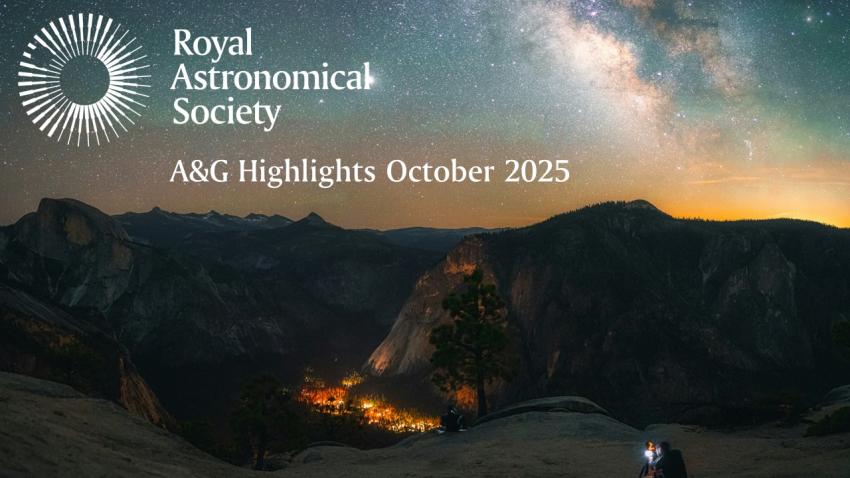A&G Highlights Meeting Programme
10th October 2025
Book your FREE A&G Highlights Meeting Ticket
16:00 Prof Mike Lockwood (President)
Welcome and Announcements
16:05 Prof Debora Sijecki (University of Cambridge)
“The Emergence of Black Holes at Cosmic Dawn”
“Black holes are among the most enigmatic and awe-inspiring phenomena in the Universe, lying at the intersection of mathematics, physics, and astronomy. Since their theoretical prediction, understanding their existence, origin and nature has been one of the deepest conundrums scientists have faced in unravelling the mysteries of the Universe. A large body of work has demonstrated that massive black holes are not only fascinating objects in their own right, but also play a fundamental role in shaping the properties of galaxies, including our own galaxy, the Milky Way.
Today, we stand at the forefront of a golden era of black hole discoveries, from the spectacular mergers of stellar-mass black holes that defy current theories, to the first-ever detections of black holes at Cosmic Dawn. In this talk, I will take you on a journey through the cutting edge of black hole discovery and address some of the most pressing questions we face: How did black holes emerge at the dawn of time? Can black holes reshape the entire galaxies they inhabit? What role do they play in the grand story of the Universe?”
Prof. Debora Sijacki is a Professor of Astrophysics and Cosmology at the Institute of Astronomy, University of Cambridge, and Deputy Director of the Kavli Institute for Cosmology, Cambridge. She completed her PhD at the Max Planck Institute for Astrophysics in Germany with summa cum laude and was awarded a prestigious fellowship at the Institute of Astronomy, University of Cambridge, followed by a Hubble Fellowship at the Center for Astrophysics, Harvard.
Sijacki’s research aims to develop realistic numerical models of the Universe that capture the formation and growth of cosmic structures with an unprecedented level of realism. She pioneered the field of supermassive black holes in cosmological simulations and demonstrated that black holes are central to galaxy formation and must be understood to extract precision cosmology from diverse observational probes. Sijacki’s work highlights the vital role of high-performance computing in cosmology and astrophysics. She has been awarded over 330 million CPU core hours on major supercomputers in the UK, EU, and US. She has received the Otto Hahn Medal, an ERC Starting Grant, and the 2019 PRACE Ada Lovelace Award for HPC for her outstanding contributions to, and impact on, HPC in Europe.
16:40 Dr Rob Eyles-Ferris (University of Leicester)
'Trapped jets and fast X-rays from the deaths of massive stars'
The deaths of massive stars or collapsars can power the most powerful explosions in the universe - gamma-ray bursts or GRBs. As the star collapses, it forms a black hole and material from the star is fired out at speeds close to the speed of light in a relativistic jet. These jets produce the GRB itself and a longer-lived afterglow across the electromagnetic spectrum followed by a supernova as the stellar material radioactively decays. The recent launch of Einstein Probe has shown that similar collapsar events can also produce fast X-ray transients (FXTs) which resemble GRBs but at much lower energies. I will discuss an FXT detected at the start of this year, EP250108a, which has unveiled some of the physics underlying these events. In particular, a fast blue optical precursor to the supernova has shown that in this case, the collapse did produce a jet but it was trapped by the outer layers of the star or the material surrounding it. Comparisons to other FXT-supernovae show that there is a broad spectrum in how these jets behave and I will discuss how Einstein Probe is finally allowing us to discover them.
Rob Eyles-Ferris is a research associate at the University of Leicester who works on high energy transients to understand the largest explosions in the universe. His particular research interests include tidal disruption events, fast X-ray transients and gamma-ray bursts.
17:15 Dr Niall Jeffrey (University College, London)
“What has AI ever done for us? – Learning about dark energy from maps of dark matter”
'What has AI ever done for us? – Learning about dark energy from maps of dark matter'
The nature of dark energy is encoded in the cosmic web of dark matter in the Universe. Using new AI techniques, we can unlock this. I will present the latest results from the Dark Energy Survey which use the gravitational lensing effect to create maps of dark matter, from which we can learn about dark energy. I will also contrast our AI approach with common perceptions of AI, showing that we employ robust scientific methods that require the development of new techniques – this set of techniques is known as "simulation-based inference". Looking forward, I will explore the excitement and the challenges that lie ahead in the era of the Euclid space mission.
Dr Niall Jeffrey - PhD UCL 2019, followed by a research position at the Ecole Normale Superieure, Paris. Currently a Senior Research Fellow at UCL.
17:55 Prof Mike Lockwood (President)
Closing Remarks


